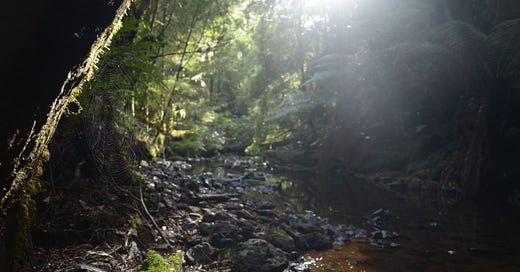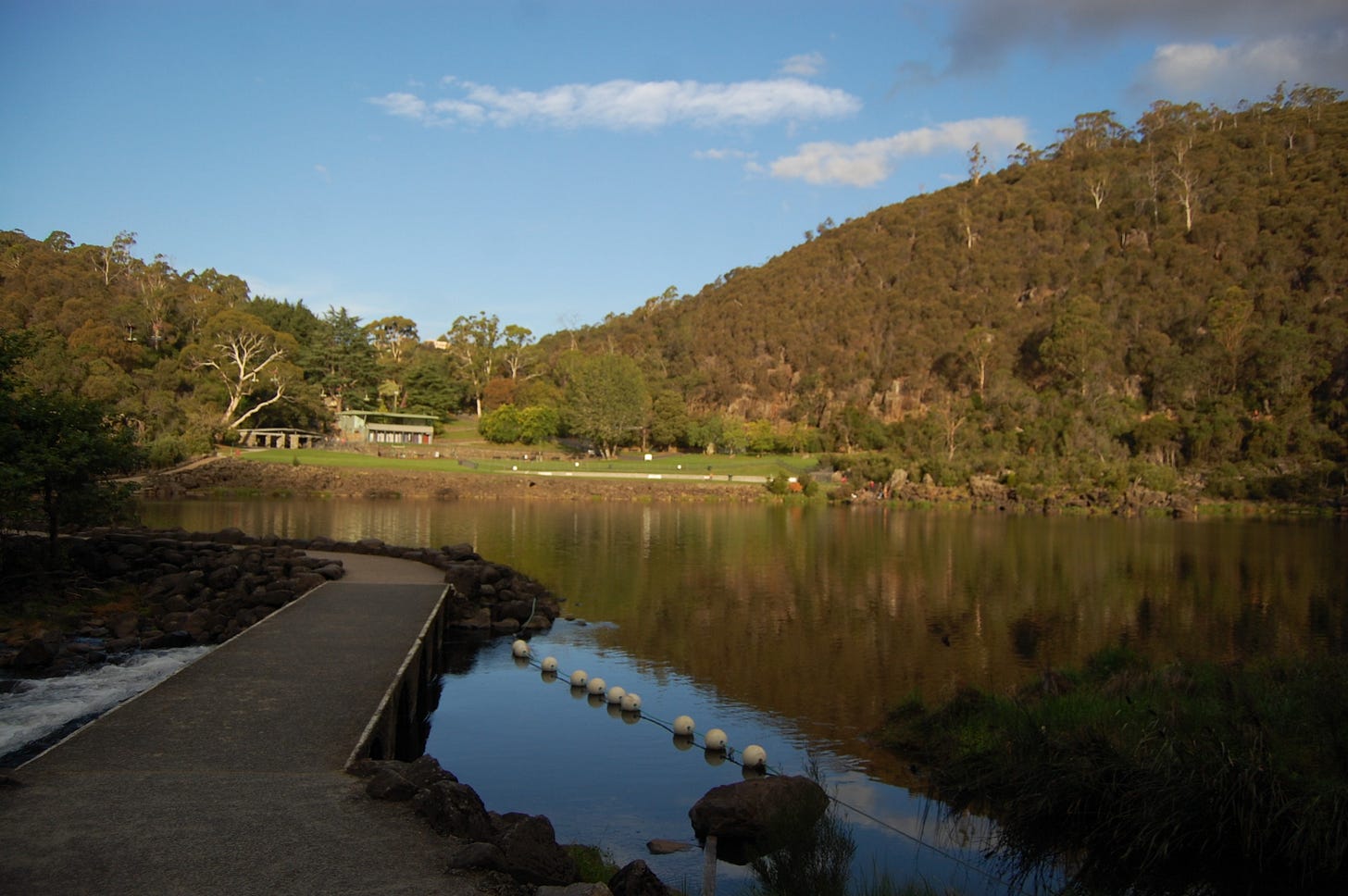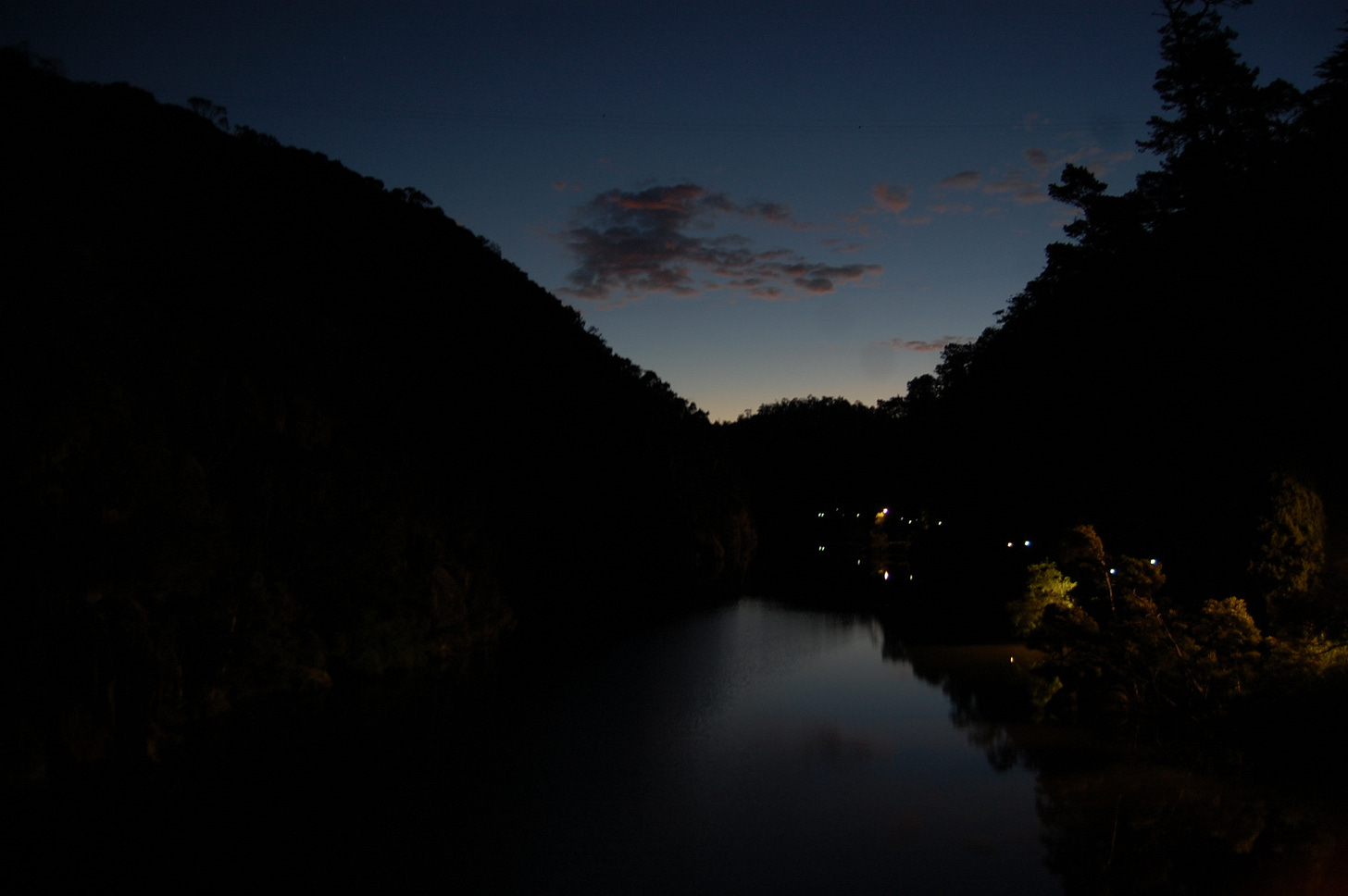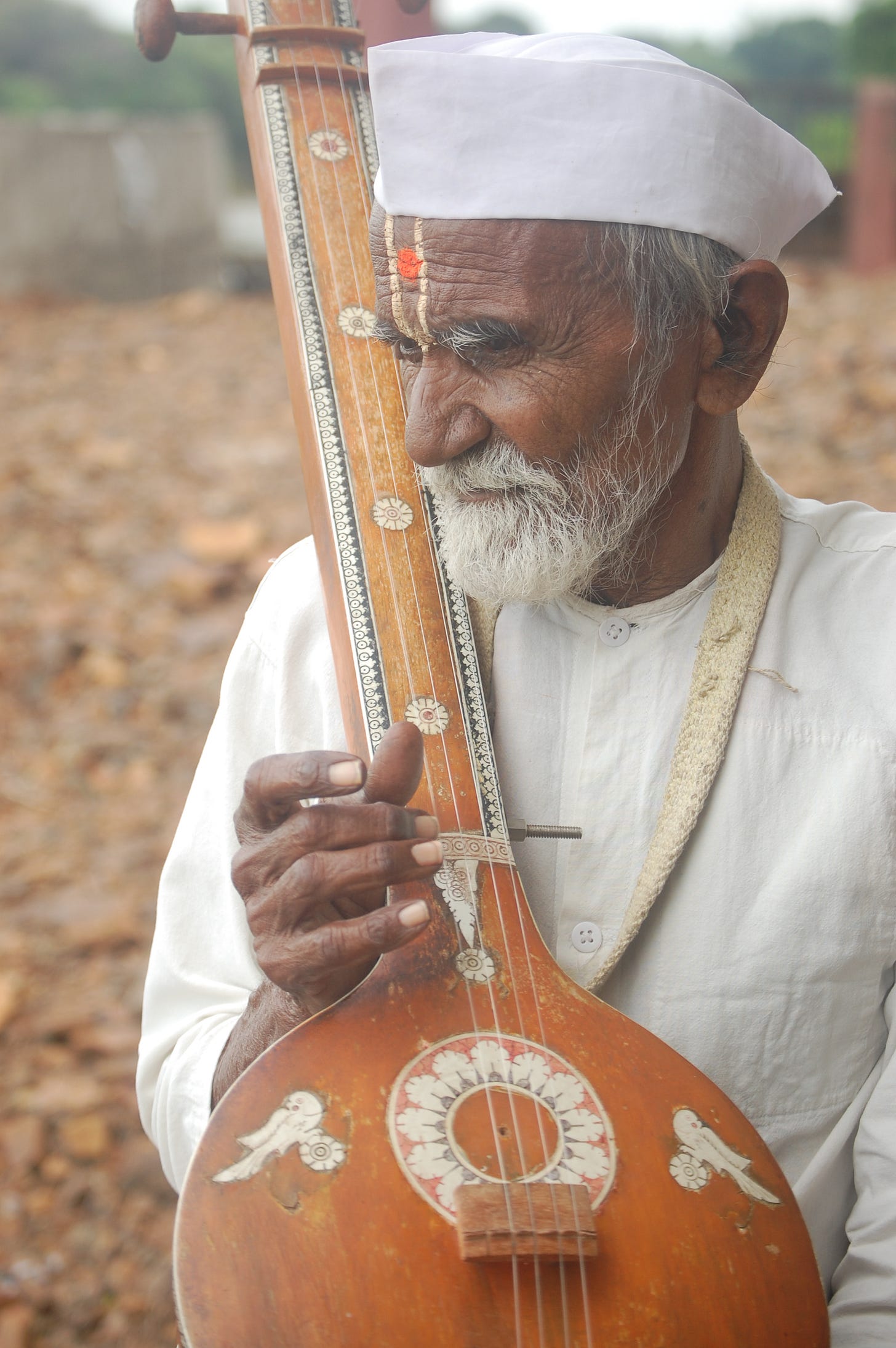The other day I walked into a gorge on an exceptionally still winter’s afternoon. It was a sleepy sort of day – I was in Launceston, which, in this season, can be as lovely as the lull in a conversation – so although the path along the river is not far from a road, I soon felt a world away.
It was a particular sound that made it most seem like I had turned away from the city and into a land of fantasy. It was the stern cry of a raven, which echoed sharply against the walls of dolerite that rise over the last stretches of that river. It was like the summons of a wizard.
Suddenly, I was attuned to all that could be heard. For instance, I became alert to a conversation that was happening on the track along the cliffs opposite. A trickle of water dropping into a puddle was like a little crystal bell. A fairy-wren skittered past my feet with a few softly-spoken syllables.
A cruise boat had chugged under the bridge and now drifted softly, with the engine off, up the South Esk River. A pre-recorded potted guide of the Cataract Gorge played through the boat’s speaker system. Four words wafted up to me; from this snippet, I understood the chapter of history that was being told.
Somewhere far away, a peacock called.
Some of my favourite travel experiences have had sound, not sight, as their primary medium.
When we’re in a new environment, most humans tend to focus on what can be seen. This is not unusual because unlike a lot of other animals, our species’ strongest sense is vision. And I definitely do a lot of gawking when I’m in a different place, but it has sometimes struck me that it’s worth the effort to bring the other senses to the fore as well.
This has become a habit for me, partly aided by a machine that I often carry around with me – a pocket-sized sound recorder. I’ve owned one of these for about fifteen years now (actually, I’ve owned about ten: they’re easily broken, as it happens, and I lost one when I was pick-pocketed); field recordings have made it into a variety of different projects that I’ve made.
None of these has honed my listening skills more than the stories that I record from my shack in the bush, a series entitled “In a Train Carriage, Going Nowhere”. Aside from my own yarns, the episodes feature plenty of noises that come from the forest around me: kookaburras cackling, possums wheezing, sulphur-crested cockatoos squawking. From the beginning, I felt like it was an important element of the production; these non-human neighbours of mine are part of the shows’ cast. Sometimes I even improvise sections of the stories so as to fit the critters’ calls.
Perhaps you have seen how concerned macropods – kangaroos, wallabies, pademelons – will rotate their ears, individually, to identify sounds that represent potential threats. If you haven’t, look it up; it’s very cute to watch the furry appendages swivel around. My own ears don’t really move – and I wear headphones when I record the train carriage tales anyway – but I still feel as though my auditory sense is swivelling about when I hear the noise of one or another creature in the background of my talking. It’s good practise.
People talk about ‘In a Train Carriage, Going Nowhere’ as a chance for them to do some contemplative thinking. On occasion I use my field recorder as a medium for meditation myself.
I’ll set up the recorder somewhere that seems to have an intriguing soundscape. Most of the time, I’ll turn the microphone sensitivity up to its maximum level. This means that any rustling leaf or twittering bird will be heard, but it also means I can ruin the recording if I breathe too heavily or my belly gurgles. An unexpected side-effect of this is a high level of concentration, not only on what’s happening around me but also what’s happening inside me.
Earlier this year, I was commissioned to make some work about Takayna country in north-western Tasmania. As well as an exhibition of found objects, I created a soundscape of field recordings, which made a fun additional task as I went on a number of road trips into the area. I often found myself in strange settings and awkward positions, trying to get the microphone in the right spot.
One afternoon near the Arthur River, I squeezed into a cavity – under some tea-tree, I think, or perhaps it was coastal wattle – and made a recording of about twelve minutes, as several small birds. Fairy-wrens chirped to one another and a thornbill fluttered so close to the microphone that when I listened back to it, the sound is reminiscent of material getting torn.
It may not seem like it to you, but such moments are utterly exhilarating – even if you do have to shake off a cramp later, or pull a bunch of leaves and twigs from your hair.
Some of my muso mates are so attuned to melodies that they hardly hear a word you say if there’s a song playing somewhere, and I can understand why: there is no magic more mesmerising than the mixture of twanging strings, resonant air, vibrating vocal chords, a recurring beat.
Years ago, on the banks of the Indrayani River in India, I was approaching by a man who had slimmed his life down to a few spare possessions and simple tasks. He strummed an instrument that was equally bare-bones – a sort of sitar, of which he only plucked one string before silently requesting a donation in return. I offered a little extra to record his sombre composition.
It was not the best music I’ve ever heard – and my Indian friend shook her head as if I was wasting money on the bloke – but it did get me thinking about how I could go about capturing these incidental music experiences.
One afternoon in Athens I wrapped it the recorder up in a pashmina scarf (mostly as both a windsock, although it’s nice to make the recorder less conspicious so no-one gets uncomfortable). I walked slowly between a corridor of calling vendors, in a busy market in the neighbourhood of Exarcheia. I caught no more than a word or two of any conversation. But with each step I gently took, I could hear that I was approaching some buskers.
Finally, I lingered in front of a trio, as they played a song of rembetiko, a genre of Greek music which I love; happily, also captured the sound of coins being thrown into a guitar case set out in front of them. (I added my own later, when the recording had finished.)
Luck struck on a different trip to India. I was on a bus in the state of Maharasthra when a passenger announced that he was going to sing. I quickly asked permission to record his performance. “Pyaar diwana hota hai,” he crooned; to tell the truth, it was a pretty good rendition. I liked it so much that I ended up making a podcast based on my experiences in Mumbai, motivated by the fine recording that I had up my sleeve.
Years later, I realised that the man had sung a Bollywood tune; the opening line can be translated “love is crazy”.
Years later, in the mountains of eastern Iran, I was invited to record a modest musical performance. It was a husband and wife duo; I don’t wish to be unkind, but although the wife had a beautiful singing voice, she didn’t have a lot of rhythm or seem to know the words to the songs.
Sadly, the recording of that session was lost – along with another recording that would have become one of my prize possessions. Some days later, I had gone to camp in a forest near the Caspian Sea. Throughout the night, my tent was visiting three times: once by cattle, another time by a wild pig, and finally, by wolves.
Naturally, I was shitting myself when I heard the wolves, even when they were far off; nevertheless, I managed to reach for my field recorder and turn it on. I promise that I wasn’t meaning to make a document of my demise, although it is also the case that I had no plan of what to do if the wolves descended on me. As it happened, they came right up to my tent, sniffed around, and trotted off, continuing to howl in the distance.
The next morning, I packed up and hitch-hiked back to the main road. I distinctly remember double-checking my campsite, knowing that I wouldn’t be able to come back if something was missing. I think I had a strange presentiment that I didn’t have everything, but it still baffles me what happened – I can’t think of any way that my field recorder could’ve been lost or taken in that time. Perhaps the wolves themselves had spirited it away.
I must say that the field recorder had got me in some trouble in that country. I had been sitting outside a Metro station in Tehran, waiting for another mate, when a man began to slowly set up his tea stall directly next to me. I quietly slipped and subtly recorded the connection of metal fittings, the scraping of materials on the ground, the muttering of however many passers-by talking in a language that wasn’t well known to me.
Then I looked up: several police officers stood over me with their hands on their hips. Another pedestrian helpfully thrust his phone into my hand. A translated note was on the screen; it asked me what I was doing. How to explain that I just liked the noises and thought it might someday become part of some soundtrack for a project I was yet to make?
I just got back from overseas, but now I’m heading out on another journey. This time I’m off East Gippsland. It’s the third time in less than a year that I’ll be heading out to this corner of Australia, a fact that makes me feel quite fortunate – it’s not the easiest place to get to, but gigs are being bestowed upon me, which it makes more than worth my while.
This week I’m creating work for the East Gippsland Winter Festival. They’re basically supporting me to do a road trip and report back after a week in the field. My itinerary will be focused on bushwalking and birdwatching, but I’ll suppose I’ll see what happens. I’ll also have my field recorder, so the journey will be shaped by sounds. I’m excited to see what comes from it. (The performance is on July 20 in Lakes Entrance – worth checking out!)
Last spring, I stayed on a houseboat on Lake Tyers. It was a beautiful experience; I’ll never forget waking up on my first morning there, to the sound of a pair of black swans murmuring sweetly to each other, directly next to the floating shack’s front deck. That space was perfect for field recordings – I managed to get a lot, from the racket of cormorants to the rumble of a thunderstorm. Many of these were worked into other projects, but much of it remains as a trove of sounds saved for a later date.
To get to and from the houseboat, I had to kayak – which meant a few stressful occasions ferrying electronic items across the lake. Still, the temptation to get some sound files from water level was too strong to resist, and one afternoon I paddled out with with the field recorder. I nosed the kayak into some paperbarks, where it stayed relatively still, and pressed the record button.
Another arvo I did a walk in Lakes Entrance, without the recorder. My ear was still attuned to sounds, however. There was a nice moment watching a whip bird scuff up the forest floor, occasionally pausing to release its famous whip-crack call.
But what I really remember from that stroll – what I wish I’d recorded – was an interaction with a man with whom I cross paths on the walking track. We were exchanged a common greeting: “How’re you goin’ mate?” But when I mentally listened back to how that had been said to me, I felt like he’d dropped so many syllables that all that remained might have been an exhortation in Japanese: “Ya-ga-me” is how I heard it.











That was truly awe-inspiring old mate. At the risk of interrupting something equally awe-inspiring I’m going to try to ring in the next few days.
Hi Bert that was lovely reading. I will be at Bungalook next Saturday to hear you. Looking forward to it very much. Warm regards Linda Damon